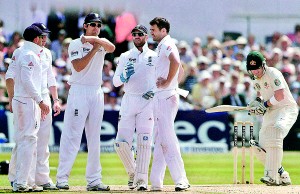Reviewing the Decision Review System
View(s):There was a time in history when England captain Mike Gatting had an open air show with Pakistani umpire Shakoor Rana. The post-incident history proves that Shakoor Rana was correct, but in fact it was a major blow to umpires standing at their home matches. This incident thus paved the way for the neutral umpire norm to be established.
It may be noteworthy to recapture the moment– one of the most bizarre occurrences in Test cricket history. Pakistani Umpire Shakoor Rana had an argument with England captain Mike Gatting in that infamous finger-wagging incident which nearly stopped the Faisalabad Test in 1987.
 The incident in question took place on the second day of a Test as Gatting was considered by umpire Rana to have made an alteration to a fielding position as off spinner Eddie Hemmings ran in to bowl.
The incident in question took place on the second day of a Test as Gatting was considered by umpire Rana to have made an alteration to a fielding position as off spinner Eddie Hemmings ran in to bowl.
Umpire Rana correctly stopped the game and pointed out the infringement. Yet at the same time he accused the England captain Gatting of cheating. By then Rana had already upset the opposite camp by wearing a Pakistan sweater and then at one juncture wore the Pakistan opening batsman Mudassar Nazar’s cap.
The world media took up the matter with glee. Shakoor refused to continue in that Test until he received an unconditional apology from Gatting. Then, Gatting was threatened of being stripped of the England captaincy and was forced into issuing a written apology to Rana. Gatting has since expressed regret at his part in the incident.
Subsequently, if one remembers, it was the former Pakistan cricket captain Imran Khan who really championed the cause of deploying neutral umpires at international matches.
Today, neutral umpires are accepted and only at games of the shorter version are local umpires honed for international challenges.
However, neutral umpires came into being when Pakistani authorities, under the insistence of Imran Khan, invited Indian umpires V.K. Ramaswamy and Piloo Reporter to stand in a Test against the West Indies at Lahore. This took place in November 1987.
Soon the ICC saw that this was the way forward and introduced the system of one neutral umpire at Test matches, which later turned into both neutral umpires at Test matches.
As a matter of fact cricketing pundits say that with the introduction of neutral umpires the ratio of home team winning has increased.
The more that cricket upgraded itself in professionalism the more urgent the call for more accurate decisions became. In this highly competitive environment, a bad decision by an umpire may poleaxe a cricketer’s career. At the same time the ICC, foreseeing this scenario, began to seek the advice and expertise of ex-cricketers in a bid to upgrade and professionalise cricket to suit the pressures of the modern game.
The next move to curtail human error in judgment at Test matches was the introduction of the third umpire by the ICC. It was used in a Test match that was played between India and South Africa at Kingsmead in 1992.

Is the Decision Review System becoming the laughing stock of the cricketing world?
The upgrading did not stop at that. The ICC’s aim was to make the right decision percentage reach the mark of 98-99%.
The Decision Review System — was introduced in 2008, when India toured Sri Lanka for a three-Test series. If I remember right it was the Indian opener Virender Sehwag who was ruled out lbw off the bowling of Muttiah Muralitharan in the second innings of the first Test. It was a tough call, but Mahela and his men, who won the match by an innings, managed to overturn umpire Mark Benson’s decision to rule the batsman not out.
During that series, which Sri Lanka won 2-0, the Lankans got it right on eleven occasions while India got it right only once. The result: the world’s richest cricketing nation India became the biggest opponent of the newly-introduced system.
I remember a former Sri Lanka President once saying that India was so against the DRS that the head of the Indian delegation, Srinivasan, at an ICC meeting went to the extent of calling it the ‘Dravid Removal System’ when India lost a series badly to England in England.
Now it seems that the DRS is coming in for a lot of criticism. There is an argument that if technology is deployed to curtail human error, then technology should be one hundred per cent right.
The Bell affair at the 2011World Cup, the Trott affair in this current Ashes series and a lot more have brought in doubts concerning the accuracy of electronically-monitered decisions.
In the current Ashes series the England one-drop batsman Jonathan Trott was given out lbw, but later it was learned that the person who handled the ‘Hot Spot’ had shown the wrong delivery.
The franchise holders of the ‘hot spot’ system admitted their fault but the batsman did not get a second chance. Also at present, they are having a series of discussions with the ICC on the subject.
It has also come to light that umpires solely do not go by the indications of the hot spot. They also give a lot of weightage to the audio feed when it comes to tip catches.Another argument that has a lot of weight is that a bizarre decision like the Stuart Broad incident, where the umpire missed a huge snick and the batsman stayed on, while the Australian camp had exhausted their referrals. Had the umpire got it right at that moment maybe the end result of that particular game or even the entire series would have been different.
Even in this series against South Africa there were two very clear bad decisions. Both were umpire referrals. In the first instance Mahela Jayawardene was stumped off off-spinner Robin Peterson. It was very marginal, and the third umpire had to decide if a part of Jayawardene’s boot was behind the crease. After a long deliberation the third umpire declared it was not out. The second was when South African batsman Faf du Plessis was stumped by Kumar Sangakkara off the bowling of Lankan left armer Rangana Herath. This too was marginal. The third umpire had to determine if Du Plessis’ boot was in the air or grounded. After a long deliberation the umpire declared that the batsman was out.
However TV replays showed that both were very marginal. Isn’t it the practice that a doubt goes in favour of the batsman? We feel that to rule a batsman out, there should be enough proof. Or else it must be the good old stage where the umpires went by their instinct and the interpretation of the law to arrive at their verdict.
Yet, the ICC says that the DRS has come to stay. However, at the same time the ICC also has put the onus on the respective countries whether to have the system in place or not during a series. The fault lies at this point. If a new rule or a system is adopted – right or wrong – it should apply to every cricketer. It should be a blanket rule. Just because India is rich and powerful it should not be given the opportunity to bully the rest of the cricketing world. At the same time if the system is expensive the ICC must foot the bill and find a way to make that money through the game itself.
Follow @timesonlinelk
comments powered by Disqus


